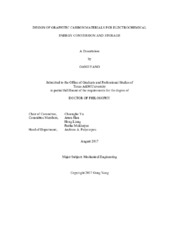| dc.contributor.advisor | Yu, Choongho | |
| dc.creator | Yang, Gang | |
| dc.date.accessioned | 2020-02-24T21:51:25Z | |
| dc.date.available | 2020-02-24T21:51:25Z | |
| dc.date.created | 2017-08 | |
| dc.date.issued | 2017-05-19 | |
| dc.date.submitted | August 2017 | |
| dc.identifier.uri | https://hdl.handle.net/1969.1/187254 | |
| dc.description.abstract | The climate change induced by greenhouse gas emissions has urged us to look for alternative energy sources instead of relying on burning fossil fuels. Converting chemical energy to electrical energy through a zero-emission path has been regarded as a clean way for this purpose. On the other hand, storing energy from renewable energy sources such as wind and solar is another way to reduce the greenhouse gas emissions. Therefore it is of vital importance to develop electrochemical systems with high energy conversion and storage efficiency. The key of electrochemical systems is electrode, where all electrochemical reactions are happening. This work is about designing graphitic carbon based materials to improve the energy conversion and storage efficiencies in fuel cells and lithium batteries.
Fuel cells have been regarded as attractive systems for the next generation energy conversion because of their high efficiency and low emission together with their modular and distributed nature and zero noise pollution. The most limiting factor comes from the cathode, where expensive Pt catalysts are necessary to overcome high activation barriers for the oxygen reduction reaction. In this dissertation, a number of graphitic carbon based catalysts have been developed without using any precious metals to replace the expensive Pt catalysts. The designed catalysts demonstrated outstanding catalytic activity and stability in both acidic and alkaline media. Their high porosity and free-standing nature would further promote mass transfer during the reaction as well as eliminate the use of a gas diffusion or catalyst supporting layer, indicating a high promise for commercial applications.
Lithium-sulfur batteries theoretically have ~10 times higher energy density than traditional Li-ion batteries. However, the practically low areal capacity and safety issues from lithium anode prevent their commercialization. Here, a catholyte method with an efficient catholyte reservoir has been developed to solve the problem from cathode side. In order to achieve high areal capacities, a sulfur/lithium dual host has been invented to (1) increase active surface area through exfoliation of graphitic layers; (2) create effective nano-reactors to shorten diffusion length of active materials; (3) improve lithium stripping/deposition by creating lithiophilic surface. | en |
| dc.format.mimetype | application/pdf | |
| dc.language.iso | en | |
| dc.subject | Energy Conversion and Storage | en |
| dc.subject | Graphitic Carbon Materials | en |
| dc.title | Design of Graphitic Carbon Materials for Electrochemical Energy Conversion and Storage | en |
| dc.type | Thesis | en |
| thesis.degree.department | Mechanical Engineering | en |
| thesis.degree.discipline | Mechanical Engineering | en |
| thesis.degree.grantor | Texas A&M University | en |
| thesis.degree.name | Doctor of Philosophy | en |
| thesis.degree.level | Doctoral | en |
| dc.contributor.committeeMember | Han, Arum | |
| dc.contributor.committeeMember | Liang, Hong | |
| dc.contributor.committeeMember | Mukherjee, Partha | |
| dc.type.material | text | en |
| dc.date.updated | 2020-02-24T21:51:25Z | |
| local.etdauthor.orcid | 0000-0002-8056-7861 | |


